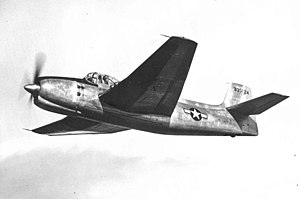Vultee XA-41
| Vultee XA-41 | |
|---|---|

|
|
| Type: | Dive fighter |
| Design country: | |
| Manufacturer: | |
| First flight: |
February 11, 1944 |
| Number of pieces: |
1 |
The Vultee XA-41 (factory designation Model 90) was an American fighter aircraft for close air support . Originally, the XA-41 was intended as a dive fighter aircraft . However, as it was believed, based on experience with the United States Army Air Corps (USAAC), that dive bombers are too vulnerable to attacks by fighter planes, the original intention was not to use the XA-41 as such. Although the XA-41 was a powerful fighter, it was overtaken by more advanced technology and never went into mass production.
Design features and development
The engineers at Vultee built the XA-41, which was called the Model 90 in-house, around the large, 2237 kW Pratt & Whitney R-4360 Wasp Major multiple radial engine. The wing layout was similar to that of the earlier Vengeance . The leading edge of the wing was not swept, while the trailing edge was clearly negative swept. The outer wing sections had a slight V-position . In addition to an externally suspended bomb load, bombs could also be carried in a bomb room in the fuselage. The single-seat cockpit was level with the leading edge of the wing and thus enabled a good view downwards.
After the priorities regarding use changed during the development phase, the two originally ordered prototypes were canceled. Nevertheless, the United States Air Force (USAAF) pushed for the completion of the first prototype as a test vehicle for the Wasp Major engine, which was also to be used in the Boeing B-29 .
testing
The XA-41 with the USAAF serial number 43-35124, which flew for the first time on February 11, 1944, showed good flight performance with a top speed of 570 km / h (354 mph) and very good controllability, with which one even had a P-51 Mustang could turn. However, since the military orders did not materialize due to the approaching end of the Second World War , there were no more orders for series production. The aircraft was therefore only used by the USAAF as a test vehicle for engines and by the US Navy in comparative flights with other contemporary attack aircraft, such as the Douglas AD-1 Skyraider and the Martin AM-1 Mauler . The aircraft then went to the Pratt & Witney department at United Aircraft to continue engine testing with the civil aircraft registration number NX60373N . The testing was completed in 1950 and the aircraft was then scrapped.
Technical specifications
| crew | 1 |
| length | 14.83 m |
| span | 16.46 m |
| height | 4.24 m |
| Wing area | 50.2 m² |
| Empty mass | 6,078 kg |
| Max. Takeoff mass | 10,971 kg |
| Engine | a Pratt & Whitney R-4360 Wasp Major radial engine with an output of 2,237 kW (3,041 hp) |
| Top speed | 584 km / h |
| Operational range | 1,290 km |
| Max. Range | 1,530 km |
| Service ceiling | 8,900 m |
| Climb performance | 832 m / min |
| Armament | four 0.50-inch machine guns in the wings, 2,900 kg bomb load, 8–12 missiles |
literature
- Anson McCullough: Grind 'Em Out Ground Attack: The Search for the Elusive Fighter Bomber . In: Wings Vol. 25, No. 4, August 1995.
- Jonathan Thompson; Vultee Aircraft 1932-1947 . Narkiewicz / Thompson, Santa Ana, California 1992, ISBN 0-913322-02-4 .
Web links
Individual evidence
- ↑ Thompson 1992, p. 119.